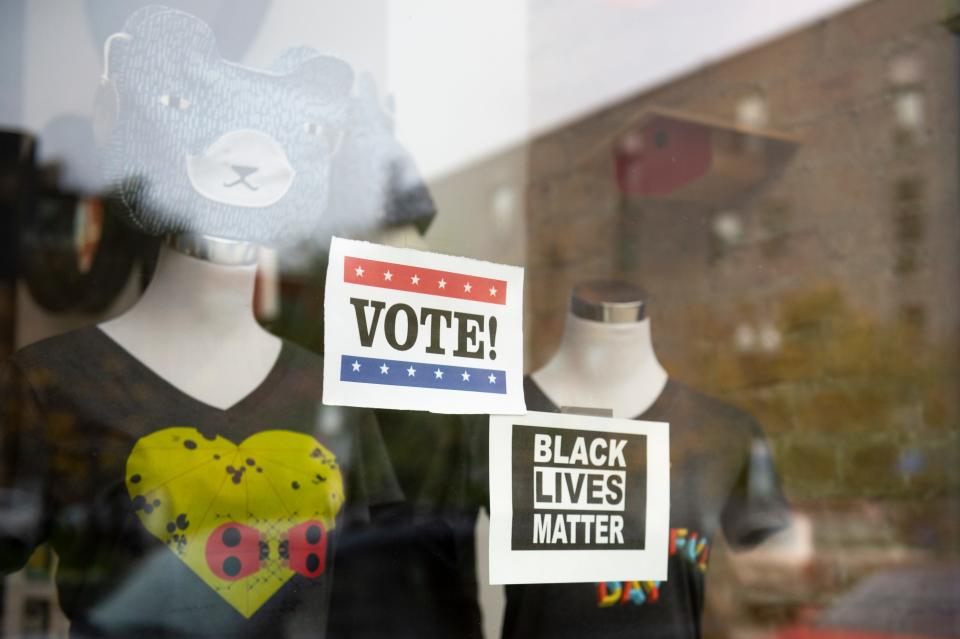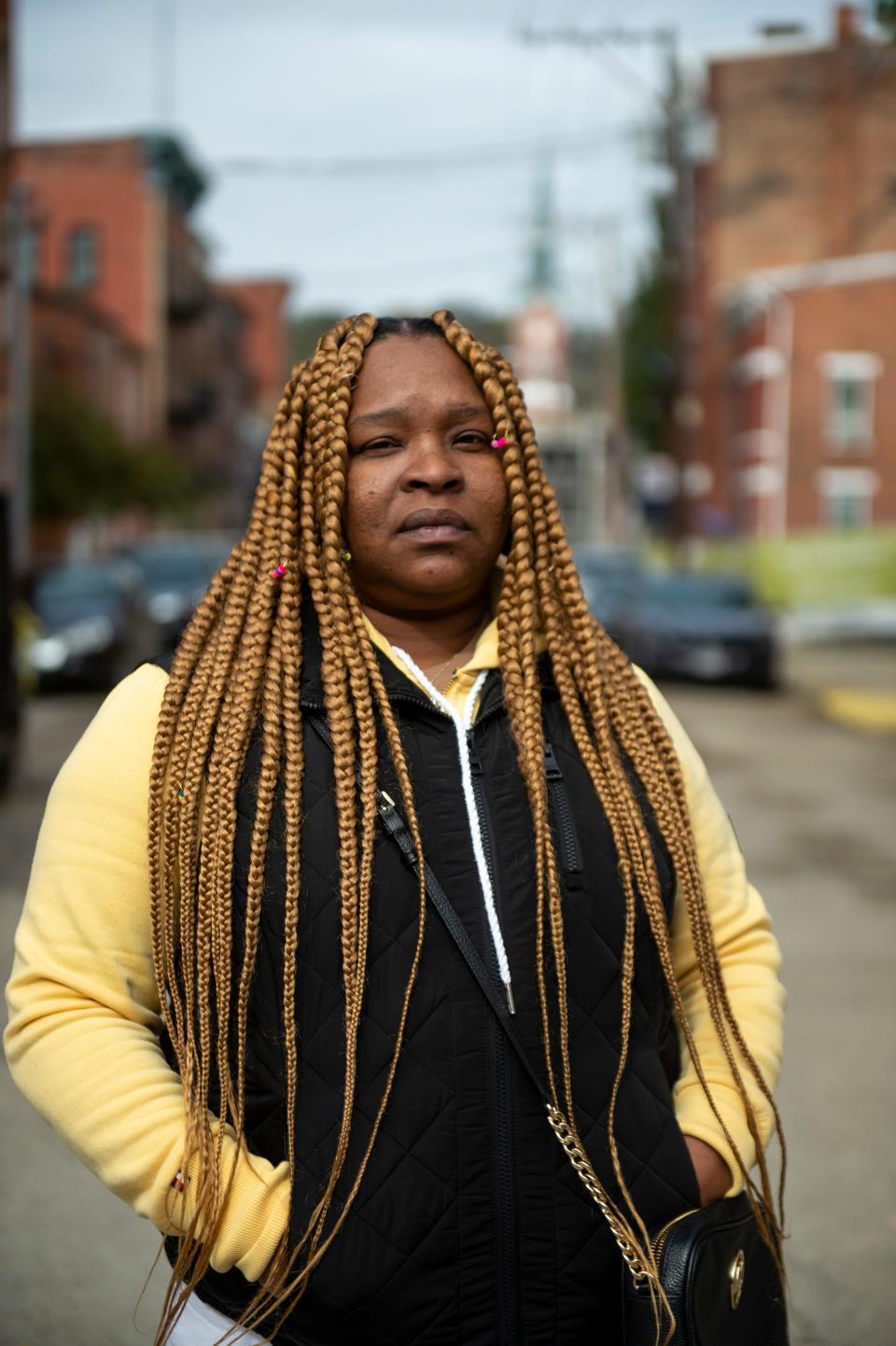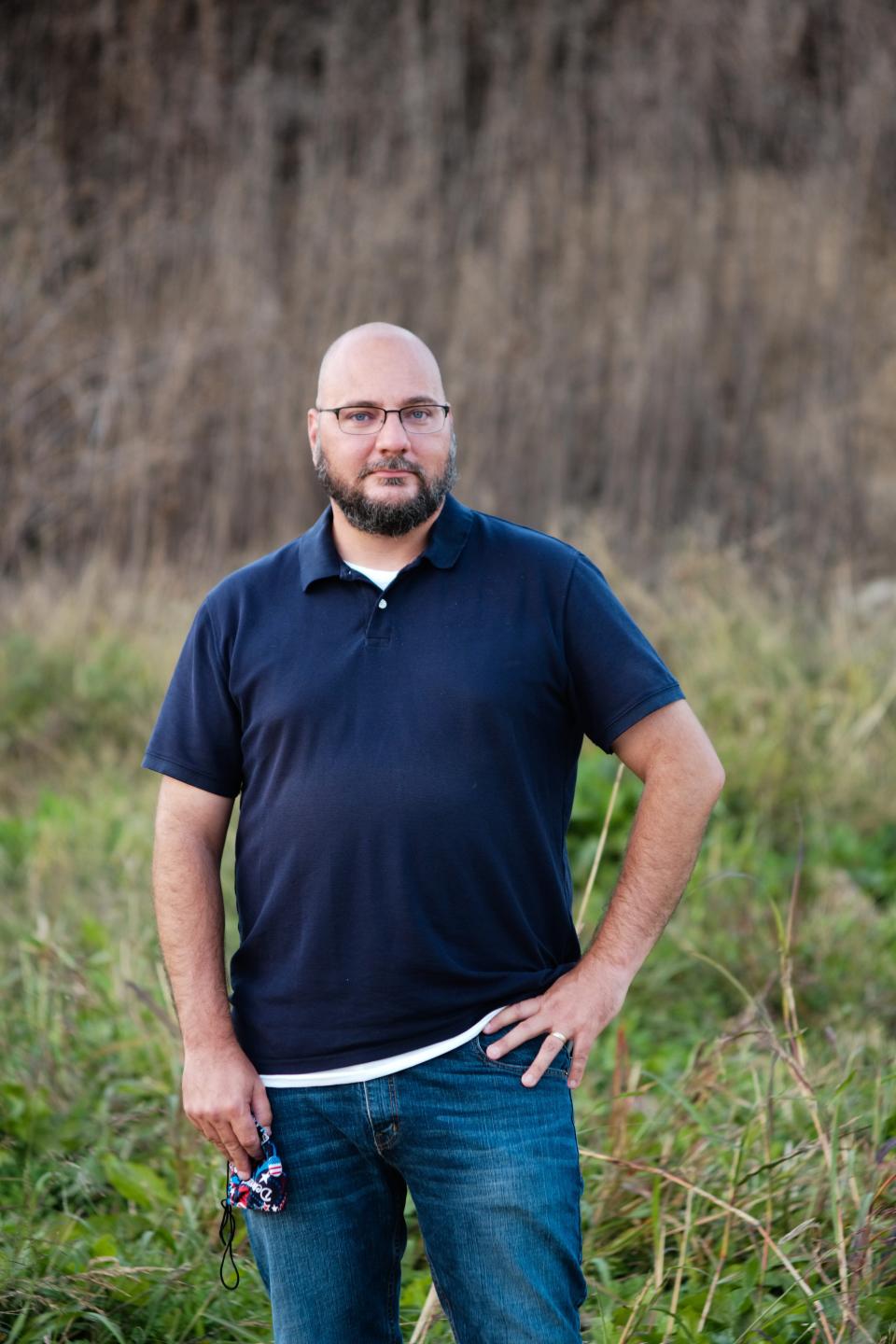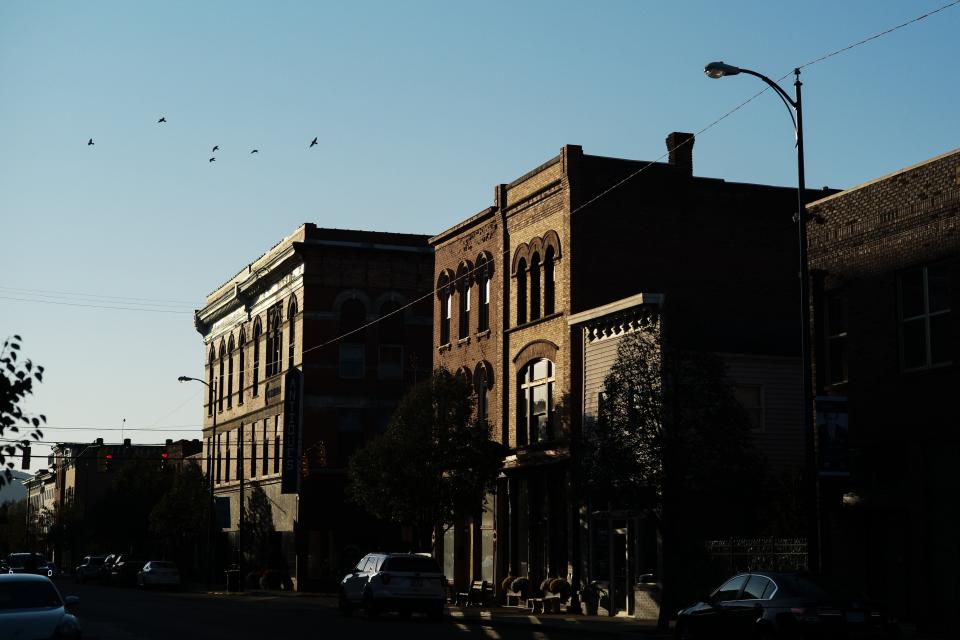Ohio's rural-urban divide drives politics, to voters' dismay. 'You're either this or that.'
WOODSFIELD, Ohio – If you draw a line across Ohio, starting at Youngstown, west to Canton and southwest through Columbus and Cincinnati, you’ll roughly split the state in half.
The southeastern half has just one Democrat at the Ohio Statehouse. A decade ago, there were 10.
That Democrat, Rep. Jack Cera, is term-limited this year. He isn't sure Democrats will hold on to the seat that snakes along the Ohio River on the state's eastern-most edge.
Roughly 100 miles away, Republicans in Franklin County worry they'll lose a few more Statehouse seats in the state's most populated county.
Party politics have changed in Ohio and across the country, as have demographics. The result: Democrats have lost ground in rural areas and Republicans have a hard time winning in urban areas.

The best predictor of whether a state will vote red or blue is whether more people live in urban areas vs. rural places, said Will Wilkinson, vice president for research at the Niskanen Center, a moderate D.C. think tank.
Ahead of the election, USA TODAY Ohio Network reporters and photographers visited four counties across the state to talk with people about this divide – what has caused it and what might heal it.
Most people spoke of national politics that don't reflect the cities and small towns they live and work in, as well as frustrations about the way in which their communities are represented.
Reliably blue, now red

Dick Yoss has three signs in front of his downtown Woodsfield law office, which faces Monroe County’s elections office and sits kitty-corner from the county’s historic courthouse.
Make America SANE AGAIN... Biden-Harris... RESTORE SANITY and DECENCY – VOTE FOR JOE!
Yoss, a former county prosecutor, made the first sign himself. He gave nearly 100 away. They dot lawns along the main road in Woodsfield, as well as homes further out in the rolling hills of this Ohio River county. The sanity signs outnumber the actual Biden signs here.
Monroe County voted for a Democrat for president in every election from 1976 to 2008. Republican Mitt Romney broke the streak in 2012, with 52% of the vote. Four years later, Trump won big with 72% of the vote.
Democrats in the county aren’t ready to give it up. They point to Trump as the disruptor more than a swing toward the Republican Party.
There used to be coal jobs here, glass factory jobs, steel jobs, union jobs. Used to. Trump tapped into that feeling of being forgotten. Yoss believes Trump's celebrity appeals to Monroe County voters.
"People often just want a change," Yoss said.

But it’s hard to ignore the effect of national party politics.
"The problem you’re up against is they watch the news, they hear the national Democrats’ message and it’s not their issues,” Cera said.
For example, gun control doesn't play well in his district. Cera has sided with Republicans on gun bills. But he frequently agrees with Black lawmakers from cities on issues of poverty and job creation.
He sees some hope in U.S. Sen. Sherrod Brown’s ability to win statewide and, until 2018, in counties like his on a jobs message.

In Brown’s first Senate race in 2006, the Democrat won 13 of the 14 counties in Ohio’s Southeast region against incumbent Republican Mike DeWine. In 2018, he won just one county – Athens County, home to Ohio University.
Shaun Burnett, 56, grew up in Woodsfield. When he turned 18, he registered as a Democrat – an implicit requirement to work in county government. After a short stint in politics in Washington, D.C., Burnett returned home as a Republican.
After President Obama was elected, he got involved in tea party events. Four years ago, he jumped aboard the Trump train and made one out of plywood to display in his front yard. This year, the train is back. Taking Hillary Clinton's place locked up in front is Biden "in his basement bunker."

Burnett said Democrats lost the incentive to win votes in places like Monroe County. They've built up voting blocs in large cities – there's no chance they would let that go.
"Democrats used to be your rural party, your farmers," Burnett said, adding the party went too far left.
Emily Lallathin also left Woodsfield and came back. But she points to her experiences away at college as the difference between her and her classmates who stayed and have moved to the right.
Lallathin, 33, went to school just an hour away at Muskingum University. But the population was more diverse than Woodsfield. She actually met other students from the Middle East, a group typically only mentioned in the village Facebook group in negative posts.
The Facebook group has become especially toxic with the coronavirus pandemic and election.
"There's no gray area – you're either this or that," Lallathin said.
Wilkinson calls it "the diploma divide."
"College increases your openness to experience," he said. "You meet the Muslim kid in your class. You meet African-Americans you never would have run into in your hometown. Lots of things that make you feel exotic and strange become comfortable."
And as many good-paying jobs have left rural areas, they've consolidated in cities and suburbs, drawing the college educated away.
"In order to make the most of your college degree, you have to move to a major labor market and that’s all consolidating," Wilkinson said.
Trump won the non-college educated vote in 2016. And in Ohio, that group of voters favored Republican Gov. Mike DeWine, too.
Trump accelerates the divide in urban counties
The house has Biden banners hanging from its front porch and a Black Lives Matter sign in the front yard.
“This will be a good one,” Republican statehouse candidate Mehek Cooke says, campaign literature in hand. She presses the doorbell, steps several feet back from the door and waits.
No one’s home.

Cooke leaves a glossy card on the doormat. She checks the canvassing app on her phone for the next house on her list in this big-tree neighborhood located in the farthest northwest corner of Columbus.
Cooke works from a list of independent and Democratic voters – she has to.
The district was represented by a Republican since it was based in Franklin County in 1992. But in 2018, the seat flipped blue.
Democrats picked up seven Statehouse seats that year, including three state representatives and one state senator representing parts of Franklin County. The other seats were similarly located in more suburban areas outside Cleveland, Cincinnati and Akron.
Cooke introduces herself as someone born in India and raised in Ohio, as a candidate who wants to build unity. Then she says she’s a Republican: "I don't want to be judged by what's happening nationally."
That admission gets her an “oh, no” from independent voter Jim Herron, 79. Later he says he doesn’t trust politicians, period, and votes for the candidate who is the lesser of two evils rather than along party lines. And he doesn't like Donald Trump.
Herron said he stays out of politics, but the growing divide between the parties – that if you’re a Republican you have to do one thing and if you’re a Democrat you have to do another – concerns him.
"There’s a lot of problems that could be solved if you could give and take a bit," Herron said.

County-wide, Republicans used to dominate in local and Statehouse races and won Columbus mayoral races. The 2018 suburban blue wave caught one of those officials, auditor Clarence Mingo, who had previously won two elections. Now there are just two county elected Republicans, the engineer and prosecutor.
Mingo, who is Black, had been a rising star in the party and briefly ran for state treasurer. He said Republicans have become more tribal, as have Democrats. Politicians are unwilling to buck the party line and voters don't consider splitting their tickets.
"The consequence is you can almost look at a zip code and determine whether or not a person in that zip code is a Republican or a Democrat," Mingo said.
Mingo said that past the Trump era, whenever that is, Republicans need to show voters they are committed to issues that aren't solidly in the conservative box, such as race relations and poverty.
"The consequence of the last four years is there are a lot of Republicans in local races who are not tribal and who are considerate of other political views and perspectives alternative to conservative thought and are losing their careers or influence," Mingo said.

Hamilton County, home to Cincinnati, has seen a similar shift.
In 1992, just eight of 51 subdivisions in Hamilton County were won by Democrat Bill Clinton. In 2016, all but 12 voted for Hillary Clinton, according to county election data.
Five have made that flip in the past three presidential elections: Mt. Healthy, North College Hill City, Springdale, Springfield Township and Wyoming.
Mary Pouncy, 48, decorated the windows on her home near Cincinnati's Over-the-Rhine neighborhood with Biden/Harris 2020 painted in pink and purple pastels. She said she gravitates toward Democratic candidates based on her financial circumstances: "Because I’m poor."
"I hope Biden wins,” she said. "Trump is not for the poor. He’s only for the rich."

David Lewis, 56, was surprised to hear parts of the county, including his suburban city of Wyoming, were getting bluer. Lewis said political parties are just interested in raising money by saying things that fire up their constituencies, like about guns or abortion.
"They're both interested in saying, ‘The other side is extreme. Send me money,'" Lewis said.
Pocket of progressivism

The neon glare from the Dari Creme sign casts a glow through the parking lot in Portsmouth, an Ohio River city 92 miles south of Columbus and 104 miles southeast of Cincinnati, in early October. A breeze ushers in a gust of late-summer air and the opening notes of "Taps" in the distance.
Around the block, Kenneth Dunn, 66, plays tribute to the military anthem with his trumpet, as the sun sets over Alexandria Point Park.
A couple hours earlier a group of Scioto County residents gathered in the park, overlooking the Ohio River and Kentucky border, to discuss the upcoming election.

Frustrated by Appalachian stereotypes that paint rural Ohio as one large swath of Trump country, Ryan Ottney is running as a Democrat for Ohio State Senate's 14th District.
"I think that perception of our area, of being conservative ... I think that reinforces the conservative population here to empower them to feel like that's what controls this area," he said. "I honestly don't believe it does."
Ottney, 42, won't speak to the ignorant and rather offensive stereotypes, he said, that outsiders cast. But he has seen community members slowly become more comfortable voicing their liberal leanings.
"I think conservatives are much louder sometimes," he added, "Which gives the impression of being more."

Local historian Drew Feight said Portsmouth's progressive concentration gets written off by those same Appalachian stereotypes.
But the 2016 presidential election results are telling.
Four years ago Trump won Scioto County by nearly 37%, but within the city of Portsmouth Democrat Hillary Clinton won by almost 34%.
"The urban-rural divide, I would say that exists within Appalachia," Feight said. In Portsmouth there is a Democratic majority, he said, but that doesn't get into the national media coverage.
"People show up with their stereotypes," Feight said. "Editors have their stereotypes and they go looking for it, and they find it, and then they miss us."
Gary Harriston, a Portsmouth native, recognizes that another popular stereotype about the region assumes Black people like him don't really live in Appalachia, or cities like Portsmouth aren't actively fighting to be anti-racist.
"The African Americans living in Portsmouth today, the largest percentage of them live in the area that's known as the North End," the 67-year-old said. "And you could take a drive through the North End and you will not find a Trump sign anywhere."

And while the Black population has shrunk, along with the total number of residents living in Portsmouth — the city recorded 20,226 people in the 2010 U.S. Census, but Harriston said they were nearly 40,000 strong while he was growing up — the appreciation for African-American culture and its rich history in Portsmouth is strong.
In September, during the Portsmouth Unity Art Project's launch, the city installed historically themed unity banners and art murals honoring local abolitionists, suffragettes, Civil Rights-era activists.

The project helped restore faith in the community, Harriston said.
But celebration of Portsmouth unity can't deny the lack of economic opportunity.
The area remains a Democratic and labor union stronghold despite shrinking industry, Joe Dillow said.
"But bad policies and Reagonomics have turned jobs elsewhere," Dillow, the president of the local chapter of the International Brotherhood of Electrical Workers said. "Since industry left folks are starting to feel underappreciated."
Just down the street from the park, Justin Everman lives in Portsmouth with his grandmother and uncle. He's frustrated by so few job opportunities in the region and Trump's apathetic attitude about COVID-19 terrifies him.
The pandemic feels like a war, Everman said.
"Usually I want a Republican during a wartime, but Trump’s not that guy,” he said.

Still, hope persists. Adjunct English professor at Shawnee State University, Kasie McCreary, is buoyed by her students.
"Watching, especially a younger generation, who's seeing an Appalachian identity as a positive thing they can define and redefine is uplifting," she said.
If elected, Ryan Ottney would be the first Democrat to serve in the Ohio 14th District's senatorial history. Ottney wants to serve what he sees as a rapidly diversifying community.
"We can either embrace that community and what will be their world," he said, "or we can fight against it."

Enquirer reporter Rachel Smith contributed reporting.
This article originally appeared on The Columbus Dispatch: Battleground state Ohio's rural-urban divide frames voters' choices


